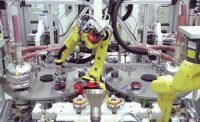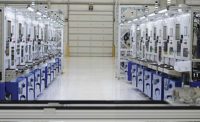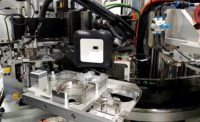One of the main challenges in forestry is removing bark from freshly cut logs. For many decades, the standard method involved loading logs into a hopper with a conveyor belt that moves the logs into a ribbed drum. There, the logs are rotated and tossed to produce abrasion that removes the bark, which is released through slots in the drum shell.
In recent decades, however, rotary debarking has become increasingly popular. This process involves using a stationary bin with protruding rotating shafts along the bottom or sides. As the shafts turn, external tooling creates cuts, fissures or weak points in the bark. Continued action of the shafts and tooling, along with stem-to-stem contact, removes the bark from the wood.
Valon Kone Ltd. has been one of the world’s leading producers of rotary debarking equipment for the past several decades. Founded in the 1940s, the company operates a state-of-the-art manufacturing plant in Lohja, Finland, that encompasses 7,774 square yards.
Jukka Jurvanen, production manager at Volon Kone, says that a robotic welding station has been an assembly process mainstay there since the facility opened in the 1980s. He points out that the company had planned to replace the original welding station in 2008, but then decided against it due to the global economic recession and the need to invest in other production machinery. As a result, the station wasn’t replaced until 2016.
“During the past few years, we have had some challenges owing to the long service life of our existing robotic welding station,” explains Jurvanen. “The investment [in a new station] fits well in [our] strategy of increasing in-house welding of parts for better quality control. [It also] allows us to weld anything from smaller high-quantity parts up to large machinery frames.”
The station was developed and implemented in collaboration with Pemamek Ltd. Before Volon Kone purchased the PEMA station, the manufacturer required Pemamek to provide simulations of it in operation on various parts. The station currently operates two shifts per week or about 1,000 hours annually, which is twice as much as the older system.
Components of the PEMA station include a robot portal; an MA1440 arc-welding robot with DX200 controller; two Skyhook workpiece positioners (a three-axis SH-3R-3 and a two-axis SH-2R-1), each with a 500-kilogram capacity; the WeldControl 300 offline-programming control system; and the CellControl 700 PC controller to monitor production.
The WeldControl system ensures robot utilization of greater than 90 percent and precise production regardless of manufacturer size. It also lets end-users integrate all power systems to a single system and program all basic functions at start-up to limit the risk of human error.
Jurvanen says Volon Kone is impressed with the six-axis robot’s slim design, quickness and large work envelope (1,140-millimeter horizontal reach and 2,511-millimeter vertical reach). The robot also features a 50-millimeter through-hole for torch cabling, sensor wires and water cooling. This design eliminates cable interference, simplifies programming and reduces cable wear.
For more information on robotized welding cells, call 358-10-501-61 or visit www.pemamek.com.





